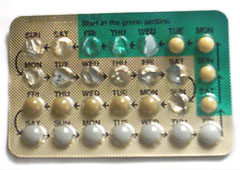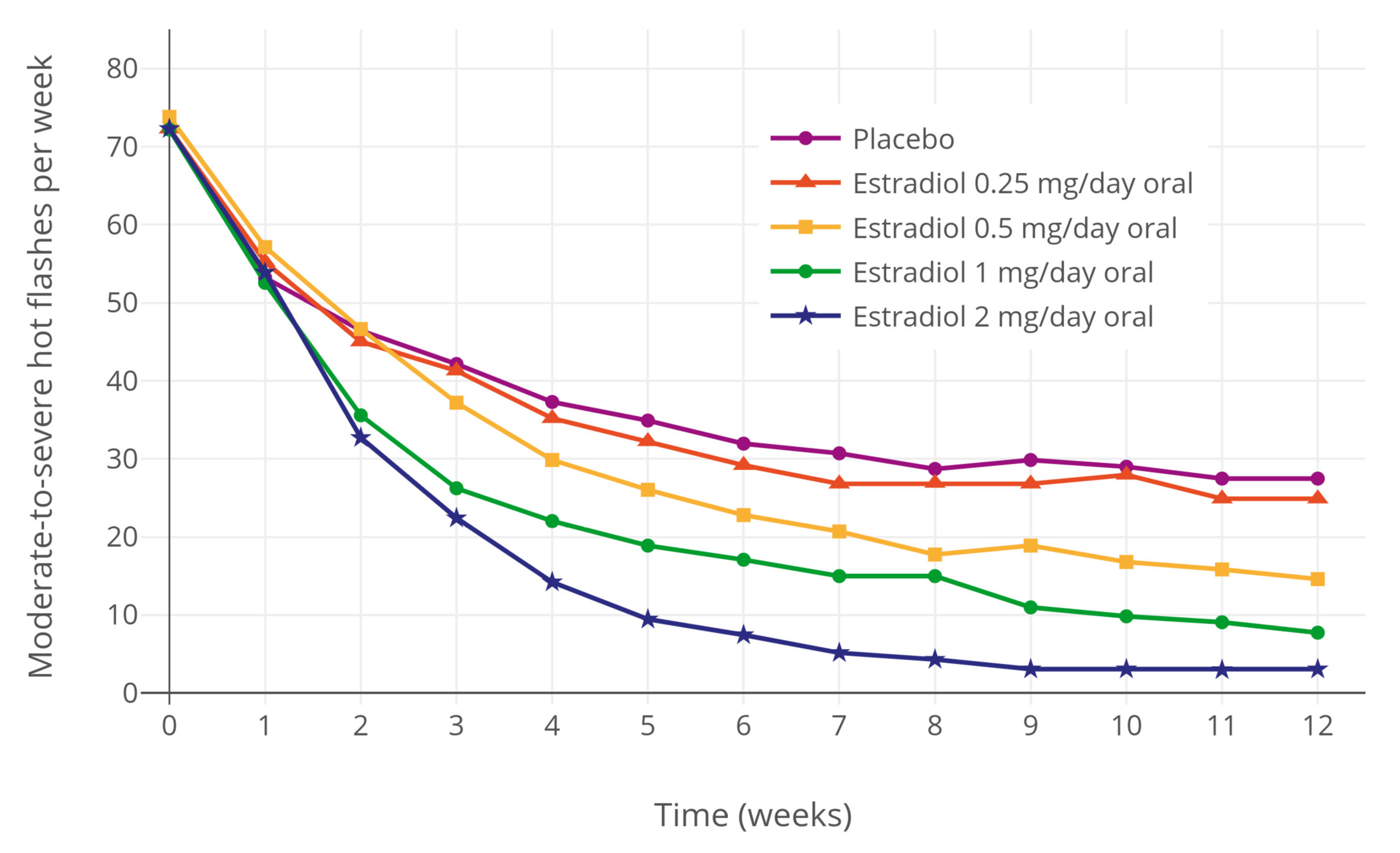|
Noretynodrel
Noretynodrel, or norethynodrel, sold under the brand name Enovid among others, is a progestin medication which was previously used in birth control pills and in the treatment of gynecological disorders but is now no longer marketed. It was available both alone and in combination with an estrogen. The medication is taken by mouth. Noretynodrel is a progestin, or a synthetic progestogen, and hence is an agonist of the progesterone receptor, the biological target of progestogens like progesterone. It is a relatively weak progestogen. The medication has weak estrogenic activity, no or only very weak androgenic activity, and no other important hormonal activity. It is a prodrug of various active metabolites in the body, such as norethisterone among others. Noretynodrel was introduced for medical use in 1957. It was specifically approved at this time in combination with mestranol for the treatment of gynecological and menstrual disorders. Subsequently, in 1960, this formulation was ... [...More Info...] [...Related Items...] OR: [Wikipedia] [Google] [Baidu] |
Birth Control Pill
The combined oral contraceptive pill (COCP), often referred to as the birth control pill or colloquially as "the pill", is a type of birth control that is designed to be taken orally by women. The pill contains two important hormones: progestin (a synthetic form of the hormone progestogen/progesterone) and estrogen (usually ethinylestradiol and 17β estradiol). When taken correctly, it alters the menstrual cycle to eliminate ovulation and prevent pregnancy. COCPs were first approved for contraceptive use in the United States in 1960, and are a very popular form of birth control. They are used by more than 100 million women worldwide and by about 9 million women in the United States. From 2015 to 2017, 12.6% of women aged 15–49 in the US reported using COCPs, making it the second most common method of contraception in this age range (female sterilization is the most common method). Use of COCPs, however, varies widely by country, age, education, and marital status. For exam ... [...More Info...] [...Related Items...] OR: [Wikipedia] [Google] [Baidu] |
Progestin
A progestogen, also referred to as a progestagen, gestagen, or gestogen, is a type of medication which produces effects similar to those of the natural product, natural female sex hormone progesterone in the body. A progestin is a ''synthetic compound, synthetic'' progestogen. Progestogens are used most commonly in hormonal contraception, hormonal birth control and menopausal hormone therapy. They can also be used in the treatment of gynecological conditions, to support fertility and pregnancy, to lower sex hormone levels for various purposes, and for other indications. Progestogens are used alone or in combination with estrogen (medication), estrogens. They are available in a wide variety of drug formulation, formulations and for use by many different route of administration, routes of administration. Examples of progestogens include natural or bioidentical progesterone (medication), progesterone as well as progestins such as medroxyprogesterone acetate and norethisterone. Side ... [...More Info...] [...Related Items...] OR: [Wikipedia] [Google] [Baidu] |
Progestogen (medication)
A progestogen, also referred to as a progestagen, gestagen, or gestogen, is a type of medication which produces effects similar to those of the natural product, natural female sex hormone progesterone in the body. A progestin is a ''synthetic compound, synthetic'' progestogen. Progestogens are used most commonly in hormonal contraception, hormonal birth control and menopausal hormone therapy. They can also be used in the treatment of gynecological conditions, to support fertility and pregnancy, to lower sex hormone levels for various purposes, and for other indications. Progestogens are used alone or in combination with estrogen (medication), estrogens. They are available in a wide variety of drug formulation, formulations and for use by many different route of administration, routes of administration. Examples of progestogens include natural or bioidentical progesterone (medication), progesterone as well as progestins such as medroxyprogesterone acetate and norethisterone. Side ... [...More Info...] [...Related Items...] OR: [Wikipedia] [Google] [Baidu] |
Mestranol
Mestranol, sold under the brand names Enovid, Norinyl, and Ortho-Novum among others, is an estrogen medication which has been used in birth control pills, menopausal hormone therapy, and the treatment of menstrual disorders. It is formulated in combination with a progestin and is not available alone. It is taken by mouth. Side effects of mestranol include nausea, breast tension, edema, and breakthrough bleeding among others. It is an estrogen, or an agonist of the estrogen receptors, the biological target of estrogens like estradiol. Mestranol is a prodrug of ethinylestradiol in the body. Mestranol was discovered in 1956 and was introduced for medical use in 1957. It was the estrogen component in the first birth control pill. In 1969, mestranol was replaced by ethinylestradiol in most birth control pills, although mestranol continues to be used in a few birth control pills even today. Mestranol remains available only in a few countries, including the United States, United Kingd ... [...More Info...] [...Related Items...] OR: [Wikipedia] [Google] [Baidu] |
Progestogen (medication)
A progestogen, also referred to as a progestagen, gestagen, or gestogen, is a type of medication which produces effects similar to those of the natural product, natural female sex hormone progesterone in the body. A progestin is a ''synthetic compound, synthetic'' progestogen. Progestogens are used most commonly in hormonal contraception, hormonal birth control and menopausal hormone therapy. They can also be used in the treatment of gynecological conditions, to support fertility and pregnancy, to lower sex hormone levels for various purposes, and for other indications. Progestogens are used alone or in combination with estrogen (medication), estrogens. They are available in a wide variety of drug formulation, formulations and for use by many different route of administration, routes of administration. Examples of progestogens include natural or bioidentical progesterone (medication), progesterone as well as progestins such as medroxyprogesterone acetate and norethisterone. Side ... [...More Info...] [...Related Items...] OR: [Wikipedia] [Google] [Baidu] |
Progestin
A progestogen, also referred to as a progestagen, gestagen, or gestogen, is a type of medication which produces effects similar to those of the natural product, natural female sex hormone progesterone in the body. A progestin is a ''synthetic compound, synthetic'' progestogen. Progestogens are used most commonly in hormonal contraception, hormonal birth control and menopausal hormone therapy. They can also be used in the treatment of gynecological conditions, to support fertility and pregnancy, to lower sex hormone levels for various purposes, and for other indications. Progestogens are used alone or in combination with estrogen (medication), estrogens. They are available in a wide variety of drug formulation, formulations and for use by many different route of administration, routes of administration. Examples of progestogens include natural or bioidentical progesterone (medication), progesterone as well as progestins such as medroxyprogesterone acetate and norethisterone. Side ... [...More Info...] [...Related Items...] OR: [Wikipedia] [Google] [Baidu] |
Norethisterone
Norethisterone, also known as norethindrone and sold under many brand names, is a progestin medication used in birth control pills, menopausal hormone therapy, and for the treatment of gynecological disorders. The medication is available in both low-dose and high-dose formulations and both alone and in combination with an estrogen. It is used by mouth or, as norethisterone enanthate, by injection into muscle. Side effects of norethisterone include menstrual irregularities, headaches, nausea, breast tenderness, mood changes, acne, increased hair growth.https://www.accessdata.fda.gov/drugsatfda_docs/label/2007/018405s023lbl.pdf Norethisterone is a progestin, or a synthetic progestogen, and hence is an agonist of the progesterone receptor, the biological target of progestogens like progesterone. It has weak androgenic and estrogenic activity, mostly at high dosages, and no other important hormonal activity. Norethisterone was discovered in 1951 and was one of the first proge ... [...More Info...] [...Related Items...] OR: [Wikipedia] [Google] [Baidu] |
Norethisterone
Norethisterone, also known as norethindrone and sold under many brand names, is a progestin medication used in birth control pills, menopausal hormone therapy, and for the treatment of gynecological disorders. The medication is available in both low-dose and high-dose formulations and both alone and in combination with an estrogen. It is used by mouth or, as norethisterone enanthate, by injection into muscle. Side effects of norethisterone include menstrual irregularities, headaches, nausea, breast tenderness, mood changes, acne, increased hair growth.https://www.accessdata.fda.gov/drugsatfda_docs/label/2007/018405s023lbl.pdf Norethisterone is a progestin, or a synthetic progestogen, and hence is an agonist of the progesterone receptor, the biological target of progestogens like progesterone. It has weak androgenic and estrogenic activity, mostly at high dosages, and no other important hormonal activity. Norethisterone was discovered in 1951 and was one of the first proge ... [...More Info...] [...Related Items...] OR: [Wikipedia] [Google] [Baidu] |
Estrogen (medication)
An estrogen (E) is a type of medication which is used most commonly in hormonal birth control and menopausal hormone therapy, and as part of feminizing hormone therapy for transgender women. They can also be used in the treatment of hormone-sensitive cancers like breast cancer and prostate cancer and for various other indications. Estrogens are used alone or in combination with progestogens. They are available in a wide variety of formulations and for use by many different routes of administration. Examples of estrogens include bioidentical estradiol, natural conjugated estrogens, synthetic steroidal estrogens like ethinylestradiol, and synthetic nonsteroidal estrogens like diethylstilbestrol. Estrogens are one of three types of sex hormone agonists, the others being androgens/anabolic steroids like testosterone and progestogens like progesterone. Side effects of estrogens include breast tenderness, breast enlargement, headache, nausea, fluid retention, and edema among other ... [...More Info...] [...Related Items...] OR: [Wikipedia] [Google] [Baidu] |
Estrogen (medication)
An estrogen (E) is a type of medication which is used most commonly in hormonal birth control and menopausal hormone therapy, and as part of feminizing hormone therapy for transgender women. They can also be used in the treatment of hormone-sensitive cancers like breast cancer and prostate cancer and for various other indications. Estrogens are used alone or in combination with progestogens. They are available in a wide variety of formulations and for use by many different routes of administration. Examples of estrogens include bioidentical estradiol, natural conjugated estrogens, synthetic steroidal estrogens like ethinylestradiol, and synthetic nonsteroidal estrogens like diethylstilbestrol. Estrogens are one of three types of sex hormone agonists, the others being androgens/anabolic steroids like testosterone and progestogens like progesterone. Side effects of estrogens include breast tenderness, breast enlargement, headache, nausea, fluid retention, and edema among other ... [...More Info...] [...Related Items...] OR: [Wikipedia] [Google] [Baidu] |
Conjugation (biochemistry)
Bioconjugation is a chemical strategy to form a stable covalent link between two molecules, at least one of which is a biomolecule. Function Recent advances in the understanding of biomolecules enabled their application to numerous fields like medicine and materials. Synthetically modified biomolecules can have diverse functionalities, such as tracking cellular events, revealing enzyme function, determining protein biodistribution, imaging specific biomarkers, and delivering drugs to targeted cells. Bioconjugation is a crucial strategy that links these modified biomolecules with different substrates. Synthesis Synthesis of bioconjugates involves a variety of challenges, ranging from the simple and nonspecific use of a fluorescent dye marker to the complex design of antibody drug conjugates. As a result, various bioconjugation reactions – chemical reactions connecting two biomolecules together – have been developed to chemically modify proteins. Common types of bioconjug ... [...More Info...] [...Related Items...] OR: [Wikipedia] [Google] [Baidu] |
Agonist
An agonist is a chemical that activates a receptor to produce a biological response. Receptors are cellular proteins whose activation causes the cell to modify what it is currently doing. In contrast, an antagonist blocks the action of the agonist, while an inverse agonist causes an action opposite to that of the agonist. Etymology From the Greek αγωνιστής (agōnistēs), contestant; champion; rival < αγων (agōn), contest, combat; exertion, struggle < αγω (agō), I lead, lead towards, conduct; drive Types of agonists can be activated by either endogenous agonists (such as |



